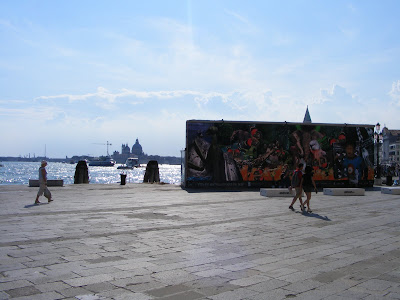On our last night in Venice we left St Mark's after seeing Sting perform. Water had filled the square and was puddling beneath the cathedral. Chains of people splashed through the growing lake as they walked home. We took the ferry along the Grand Canal where the Venetian facades were softly illuminated in the starry dark of La Serenissma. The night waters were rising above the level of the city; crashing against squares where people sat at tables drinking, lapping at the feet of buildings, nudging at doorways. At the steps of the Natural HistoryMuseum a giant crab now floated in the quietly menacing black of the water. I felt the wonder of Venice under threat.
The waters of Venice must have seeped into my imagination and soaked its liquid impression upon me. That night I had a waking dream in which the rippling springs of my mattress metamorphosed into a Traghetto on the unsettled waves, the room was filled with a shimmering blanket of water and our rucksacks became a ferry navigating the narrow passage between the bunk beds. I quietly gasped and pushed my things beneath the bed to make room for its journey. Che bello sogno Venezia! In one night I had become enrapt by La Serenissima's buoyant magic.
 The Illuminazioni signs with a map to help you navigate the events.
The Illuminazioni signs with a map to help you navigate the events.
Being in Venice during the Biennale was fabulous, our wandering of the streets was punctuated by the discovery of pavillions, installations and parallel exhibitions. The black and red signs became beacons. We were travelling across Europe on a budget so we couldn't afford to pay to get into the pavillions at the Arsenale or Giardini but enjoyed tripping up on the smaller, free exhibitions we found. I like to think we found the hidden treasures of the Biennale; the underrated and underappreciated pavillions on the fringes.

Underneath the Palazzo Ducale in the Palazzo delle Prigioni we found the The Heard and Unheard: Soundscape Taiwain. The Sound Library/Bar was one of the highlights of our chance discoveries. Kuo-Chang Liu had collected pieces of furniture from hotels and Karaoke bars in Taiwan and filled the elegant Venetian interior. Beneath the chandelier hanging from the ceiling faded leather armchairs became platforms for Taiwanese music. The circular bar in the centre served sound and video projects and the back room hosted emerging bands. The idea of a 'soundscape' is an exciting and immersive project and it managed to communicate something of popular Taiwan (with artists such as Ming-Chang Chen and Blacklist Studio) as well as an emerging, experimental art scene.
 The Taiwanese Pavillion's melding of a stunning Venetian interior with its authentically evocative furnishings perfectly captured the Biennale's success. Modern galleries with their minimal white walls which give Art 'space' can never compete with Venice. Like the waters which seeped into my dream, Venice leaves its impression upon the art, it infects it with its magic.
The Taiwanese Pavillion's melding of a stunning Venetian interior with its authentically evocative furnishings perfectly captured the Biennale's success. Modern galleries with their minimal white walls which give Art 'space' can never compete with Venice. Like the waters which seeped into my dream, Venice leaves its impression upon the art, it infects it with its magic.
 I had seen Erwin Wurm's Narrow House in Beijing's 798 factory complex, but it looked different in the sunlight on the grass in the gardens of the Glasstress. The illuminated dancers on the Canal would not have had the same waltzy joy if their shadows hadn't glittered on Venice's waters. I wasn't really gasping at the dancers as we passed either, but at the ornate balconied Venetian facade now a kaleidoscope of green, blue, red and yellow windows. I regret not being able to see Song Dong's parents Beijing house transported to the Giardini, but have at least seen something of the atmosphere which the Biennale gives Venice and Venice gives art.
I had seen Erwin Wurm's Narrow House in Beijing's 798 factory complex, but it looked different in the sunlight on the grass in the gardens of the Glasstress. The illuminated dancers on the Canal would not have had the same waltzy joy if their shadows hadn't glittered on Venice's waters. I wasn't really gasping at the dancers as we passed either, but at the ornate balconied Venetian facade now a kaleidoscope of green, blue, red and yellow windows. I regret not being able to see Song Dong's parents Beijing house transported to the Giardini, but have at least seen something of the atmosphere which the Biennale gives Venice and Venice gives art.












